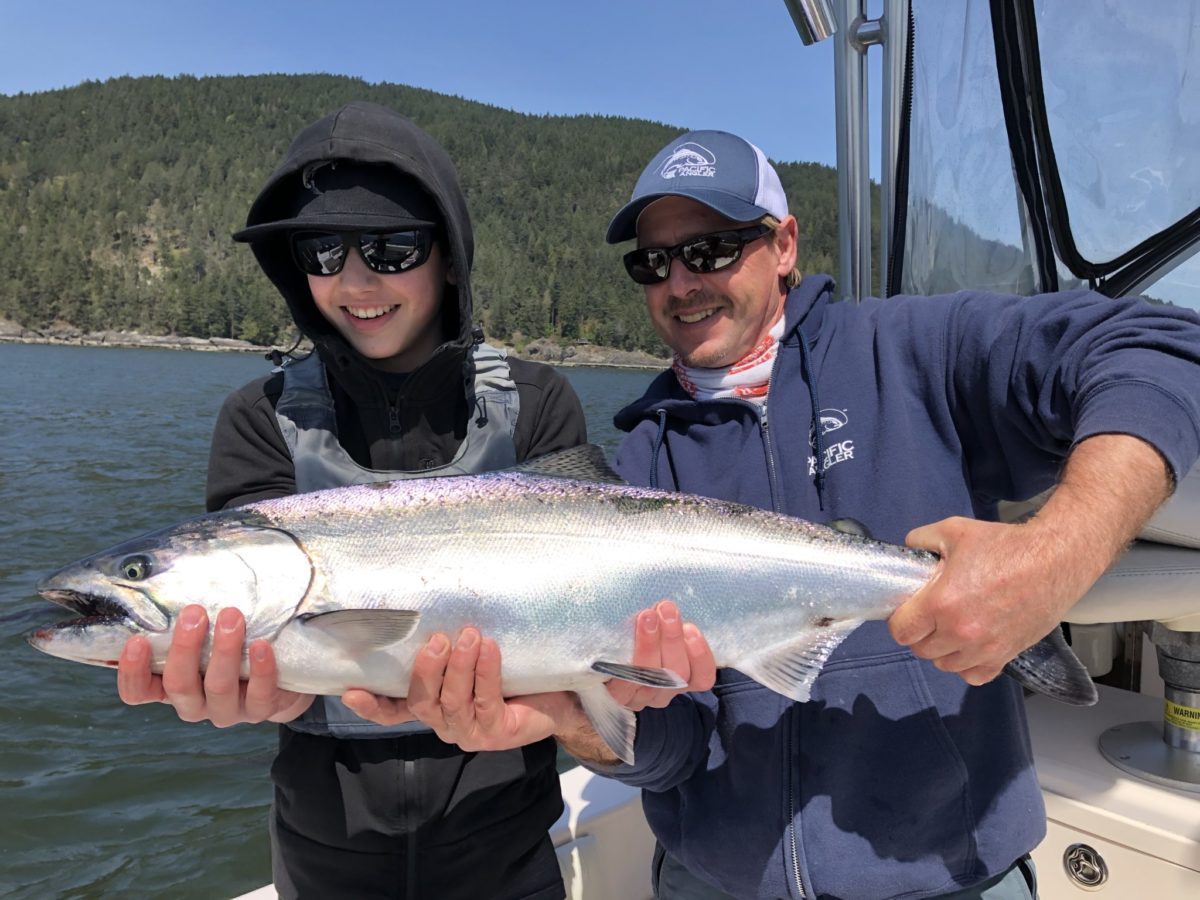OUTLOOK
Break out the sunglasses and fishing rods it is going to be a beautiful weekend and we have a big report this week with a bunch of great features and tutorials.
First off, we have a product feature update! The boys were out last weekend testing the new Amphibifin Kick Fins that we talked about in our float tube feature last week. Verdict? They Rock! They were noticeably faster and way easier to move around in when on shore or in shallow water. Don’t miss Brendan’s full review in this week’s report.
On the technique front we have a beginner’s guide to fishing leech patterns that you will not want to miss, and it leads into a fly tying feature where Zach shows us how to tie the famous balanced Vampire Leech.
Lastly, be sure to join us at some awesome upcoming events or in one of our classes. If you’re headed out on the water, we’ve got reports from lake right through to saltwater so check them out in this week’s report and we’ll see you out on the water.
INDUSTRY EVENTS AND UPDATES
Fishing For The Future
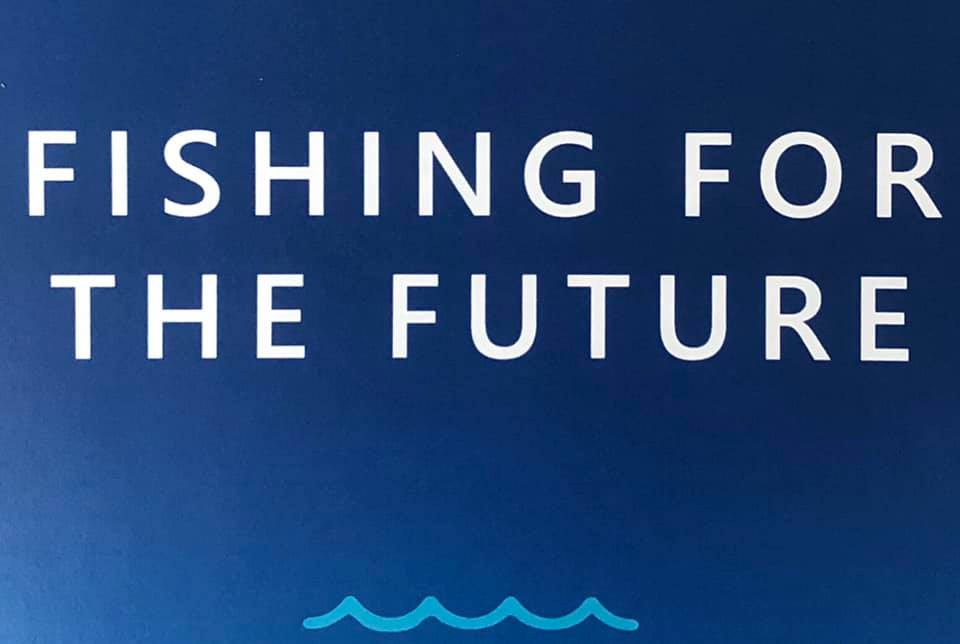
Chat, Chew and Brew. A Public Fishery Access & Awareness Event
- Expanding the distribution and reach of sportfishing issues, promotion and awareness through social and traditional media
- Sustained and regular presence in Ottawa to advocate on behalf of the sector to senior bureaucrats, Ministers and MP’s
- The creation of a legal “war chest” to build a foundation for future legal action.
Tickets are limited!!! Over 90% already sold. Get them while they are available.
Date: Saturday May 11, 2019
Time: 6PM
Location: Jimmy Mac’s Pub 19935 96thAvenue, Langley BC
Trout School
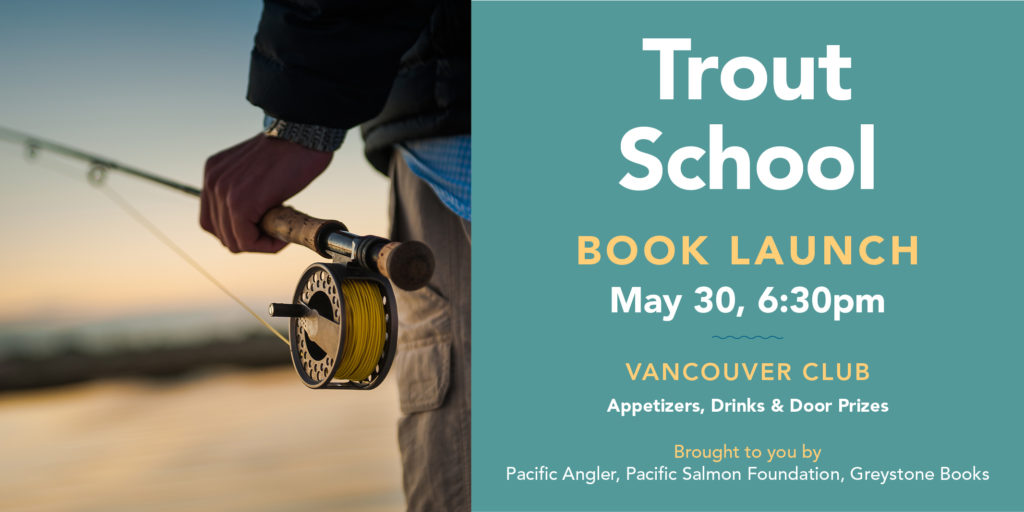
Join us for a fun, social evening celebrating fly fishing in beautiful BC. Mark Hume, an experienced angler and former Globe & Mail reporter, will give a captivating visual presentation from his new book, Trout School, which shares insider knowledge from legendary angler Mo Bradley. Mo is the undefeated master of catching Kamloops trout. This is your chance to learn from the master.
Featuring: Door prizes. Drinks. Catering. Cash bar. Books for sale.
Brought to you by Pacific Angler, Vancouver Club, and Pacific Salmon Foundation
RSVP at https://www.psf.ca/event/trout-schoolhttps://www.psf.ca/event/trout-school
Date: Thursday May 30
Time: 6:30PM
Location: Vancouver Club, 915 West Hastings Street
CLASSES AND COURSES
Introduction to Fly Fishing
This course was specifically designed to give the new fly fisher the basic knowledge, casting skills and fly fishing strategies to effectively fish our local BC waters. This course is comprised of two sessions; 3hr evening seminar and a 3hr casting session. The dates below show the seminar date first and casting date second.
Cost: $150.00 + GST
Dates: Seminar May 22 Casting May 25, 2019
Seminar Time: 6:30pm – 9:30pm
Casting Time(s): 10am – 1pm or 2pm -5pm
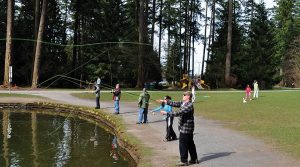
Tying Beach Fly Patterns
Join Pacific Angler for a 3hr evening seminar of tying flies specific to catching salmon on our coastal beaches. Without a doubt, fly selection is critical while beach fishing.
These flies are often not commercially available, so successful beach anglers learn to tie their own patterns. Your instructor will walk you through each fly pattern step-by-step.
This Tying Beach Fly Patterns course is suitable for fly tiers with a basic knowledge. Students are required to supply their own vise, tools and materials. A 10% discount is available on fly tying materials and tools purchased for the course.
Date: May 27, 2018
Cost: $50.00
Time: 6:30pm – 9:30pm
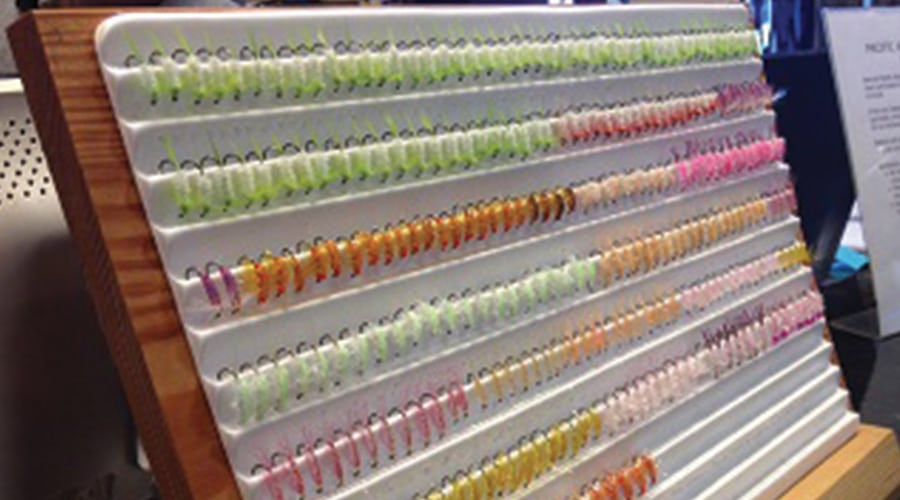
Introduction To Fly Fishing Lakes
This course will give you an in-depth look at the fundamentals of fly fishing lakes. We explore equipment, techniques, major insect hatches and ideal lakes to begin with. You will learn all you need to plan your next successful lake trip to one of BC’s 5,000 lakes! This course is comprised of one 3hr evening seminar.
Cost: $50 + GST
Date: May 29, 2019
Time:6:30pm – 9:30pm
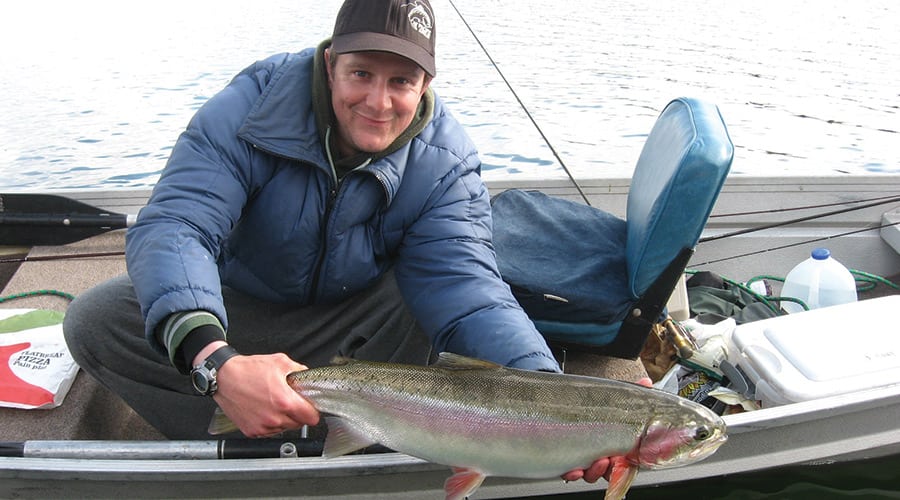
FEATURE
The Guide Amphibifin
Following up on our article on float tubes last week (if you haven’t read it, check it out here). I have an additional product report on the Guide Amphibifins. We just recently got these new kick fins in the shop and I tried them out for the first time this week.
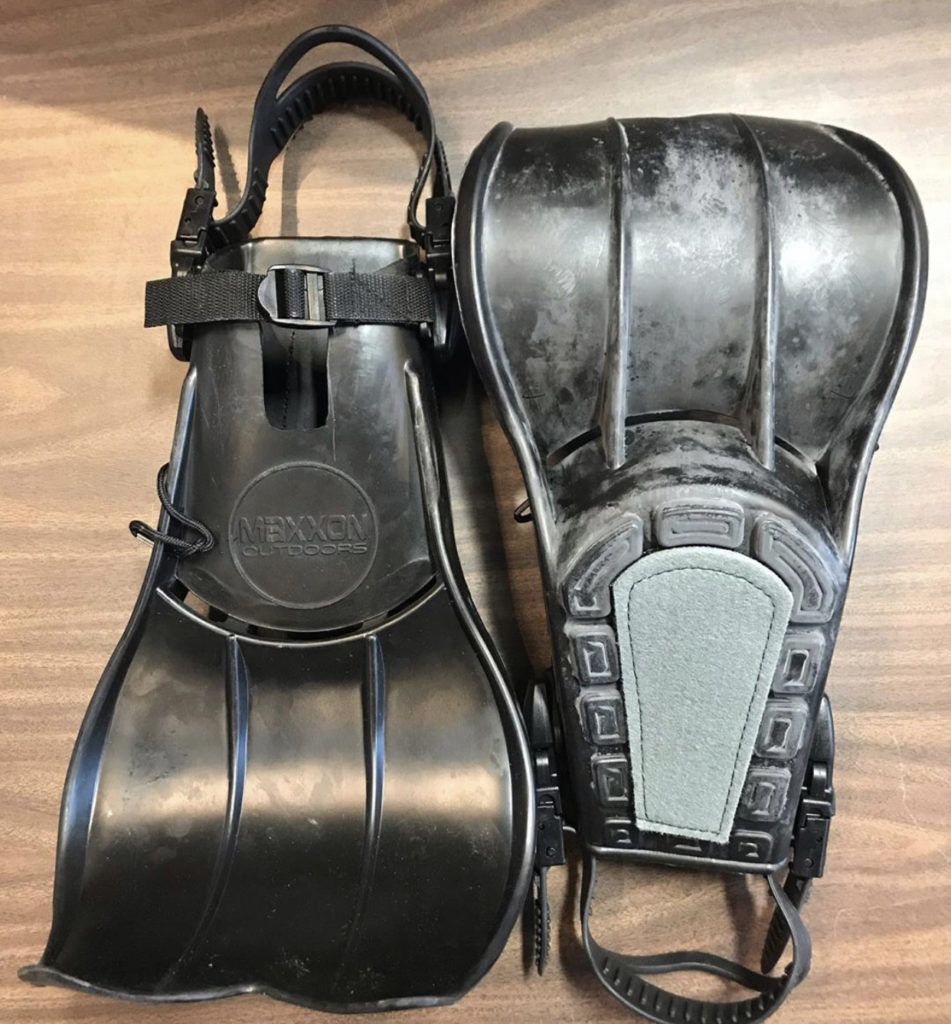
I can report that they were awesome. First off let’s talk about the design. Compared to standard kick fins, the Amphibifins are considerably shorter; however, they are slightly wider than standard fins which increases surface area inducing a more powerful kick. The fins are designed to look like a frog’s webbed-foot with an upwards facing curve at the toes. The curve allows for a more powerful kick while reducing drag and resistance making these fins considerably faster.
The feature of these fins which has impressed me the most is the removable felt pad (like your wading boots) that are fixed on a platform at the bottom of the fins. We all know float tubes can be difficult to get into sometimes and walking around in fins is just awkward. The Amphibifin’s design makes waking around and getting into your float tube or pontoon easier. The upward curved fins, along with the platform fixed on the bottom of the fins, allows for ease in walking with no extra surface area dragging on the ground. The felt bottom is an added bonus as it helps grip onto rocks and reduce slippage. I can see how Amphibifins can be a float tube and pontoon user’s new favourite fins.
Coming in at $89.99, these fins are both functional and affordable and can really increase your speed on the water and reduce your awkwardness on land.
Feel free to come by the shop anytime and check out these new fins,
Brendan Guraliuk
LAKE FISHING FEATURE
Fishing Leech Patterns
This week we are going to look at leech patterns and how we fish them.
At this time of year, most anglers are focused on stillwater fishing, and leaches are an important part of the food chain.
There are two common types of leech patterns and one new style that Andre has developed. (We will talk more about this at the end of this article).
The common types are balanced and standard. The two types need to be fished differently and if you use the wrong leech style pattern with the wrong presentation you can see a dramatic drop in production.
Standard leeches are tied on straight or down-turned eyes, and sometimes have a cone or bead head. These flies are fished on a slow retrieve in the mid water column or crawled along the bottom. Depending on desired depth these flies can be fished on any type of fly line, from full floating to a heavy sink.
The second type of pattern commonly used is a balanced leech, where the eye is located just behind the head and is angled upwards. Below Zach has a “how to” on tying this style of pattern. These flies almost always have a bead of some sort, allowing the fly to remain balanced at a level angle while suspended under an indicator. Since we are fishing these under an indicator, a full floating line is used. If you try to use a pattern that is not balanced it will sit like a vertical stick in the water and not catch as many fish.
With this presentation cast along edges and drop-offs and retrieve extremely slowly. It is useful because you can avoid bottom and you can suspend your fly right in the feeding zone. Waves and ripples on the indicator add action to the fly.
These flies are great for fishing over weed beds and around lily pads. It is also very common for hard core chironimid anglers to use a balanced leech to locate fish or to catch a fish and stomach pump him to determine the size and color or the chironimids they are feeding on.
When
choosing depth use your forceps to find the bottom then start with your fly 2
feet off the bottom. We recommend adjusting your depth every 30mins if you are
not catching anything and most angler move the indicator 2 feet every time to
zone in on a feeding depth. Come into the shop and we can show you how to do
this.
It is important to remember that when fishing these flies to use a small loop
knot. This allows the fly to swim and move freely, as well as sink faster.
The
last type of leech pattern is Andre’s double duty pattern. This is a new one
that has 2 eyes. One with the standard forward facing hook eye but it also has
a balanced loop off the top of the fly so it can be fished under and indicator.
It a great pattern when you may not have an over stocked fly box and you are
not sure what style you will be fishing.
With all leach patterns, sizes and colors can vary, and it is important to have
a variety of sizes and colours. I’ve had fish be very focused on larger patterns
suspended in the morning, only to have the fish switch to small mini and micro
leaches slowly stripped along a drop-off in the afternoon.
Come on in to the shop and any one of our friendly and experienced staff can
help you out. With many anglers starting to hit the lakes, leach patterns are a
must and you’ll want to pick some up before heading fishing as sometimes they
can be the difference.
Jordan Simpson
FLY TYING FEATURE
Balanced Vampire Leech
Balanced fly patterns and leeches in particular seem to be taking the tying world by storm as of late. I have been tying and fishing this style of leech for a couple seasons now and have had some great days on the water with them. They are fairly easy to make and once you get your proportions dialed in for the chassis you can knock out a box of these in no time. The one benefit of a balanced leech over a traditional leech, that is tied on a regular shank, is that you can hang one under an indicator and when you have a slight riffle on the water the fly will look like it is swimming in the water just like a real leech. Enough jibber jabber, let’s get to the tutorial…
Materials:
- Hook: Daiichi 4640 or 4647, Sequin pin
- Bead: Chartreuse 1/8” brass bead w/ 5 wraps .020 lead wire or 1/8” tungsten bead
- Thread: Danville’s 140 denier black
- Tail: Black zonker cut from the hide
- Body: UV black polar chenille large
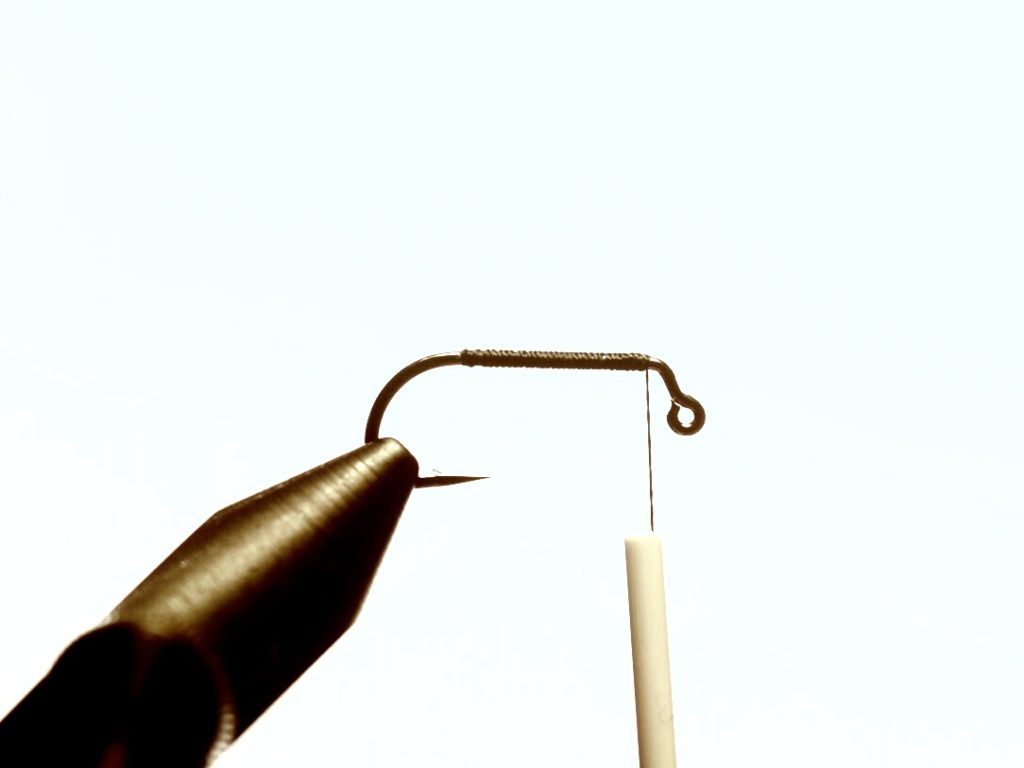
Start your thread at the eye of the hook and build a nice thread base for your pin to sit on, finish with your thread at the eye of the hook.
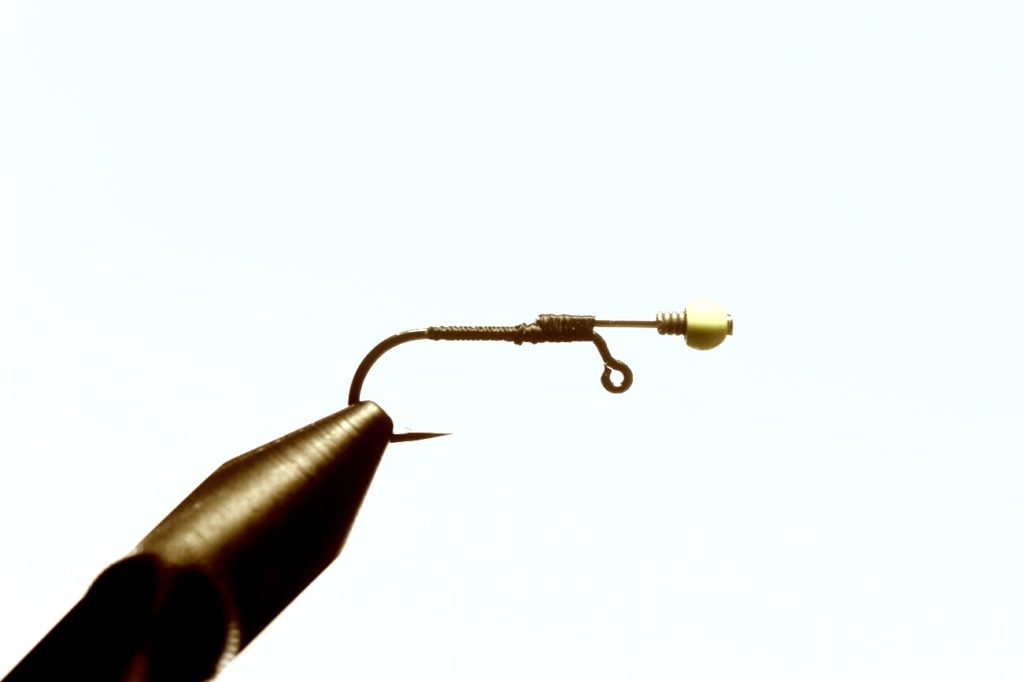
You may need to cut the pin down with a pair of side cutters to get the correct length. I find that the shorter the pin is the easier it is to get the fly to balance as it keeps the extra weight at the front of the hook. Slide your bead on the pin, if you are using a brass bead add a couple wraps of .020 lead wire to help keep some extra weight at the front of the pin. The total length of the pin sticking forward will take some playing around with to get right, I have found that if you leave enough space to fit 2-3 beads in behind where the bead is then you should have a solid balanced chassis.
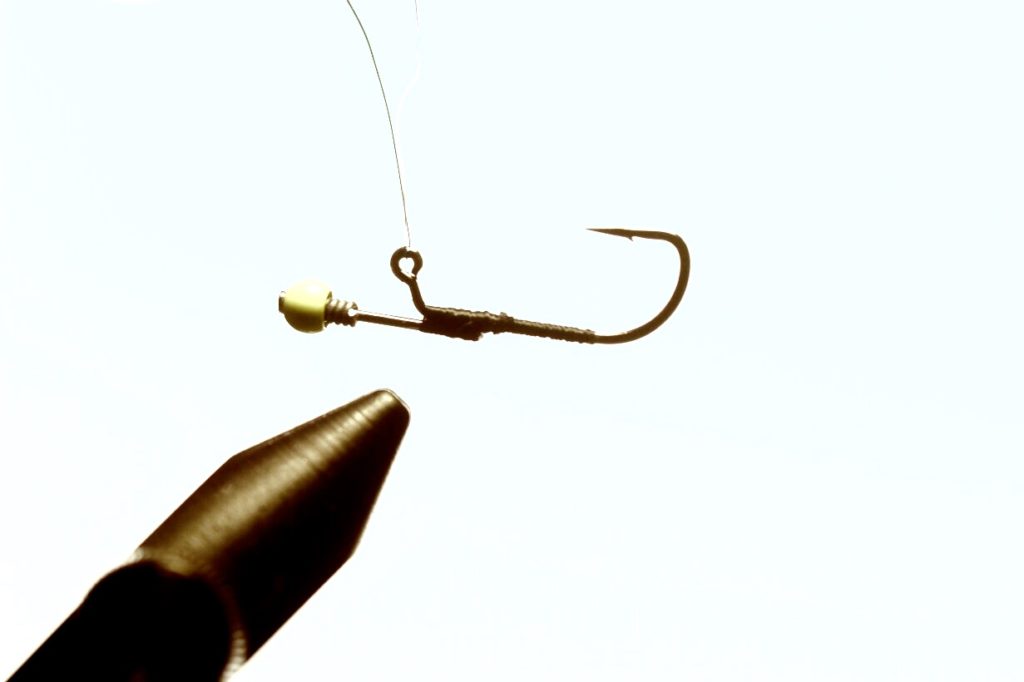
I generally like to whip finish if this is the first fly of the batch that I am tying. I take the fly out of the vice and I find a scrap piece of wire and check how the fly is balancing. It’s ok if the fly is a touch tail heavy, ideally you will want the fly to be a touch bead heavy. Adjust your pin as needed.
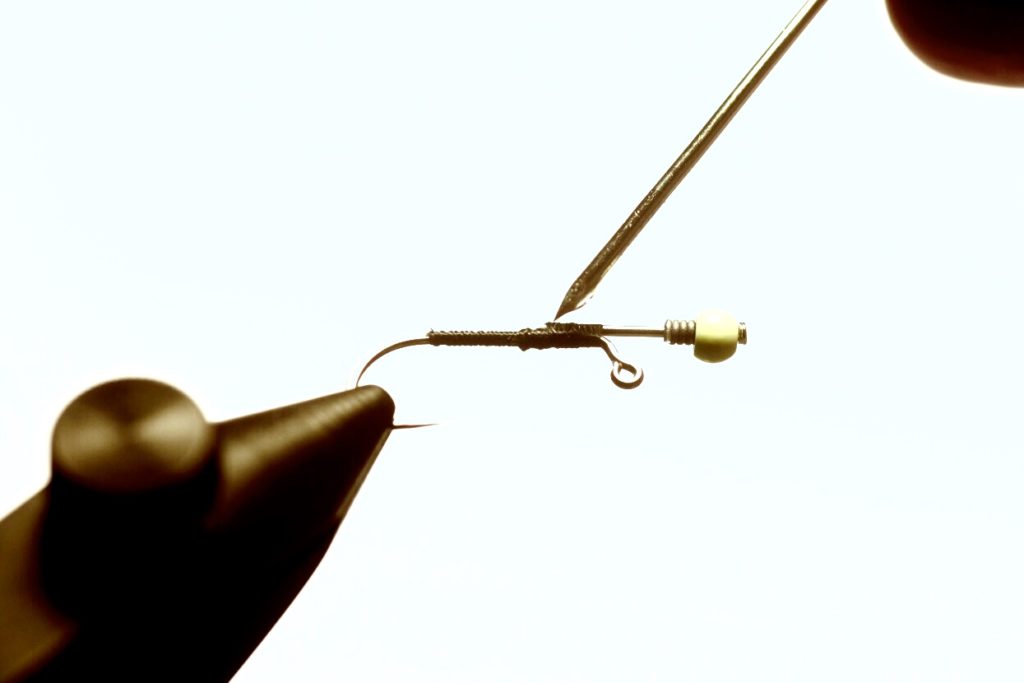
I like to soak the connecting wraps with some super glue or head cement at this point just for security. I have tied and fished a lot of these and have never had a pin fall out on me. If you are going to tie up a big batch of these I would stop here and start on the next chassis until you have enough for the number of flies that you want to tie up.
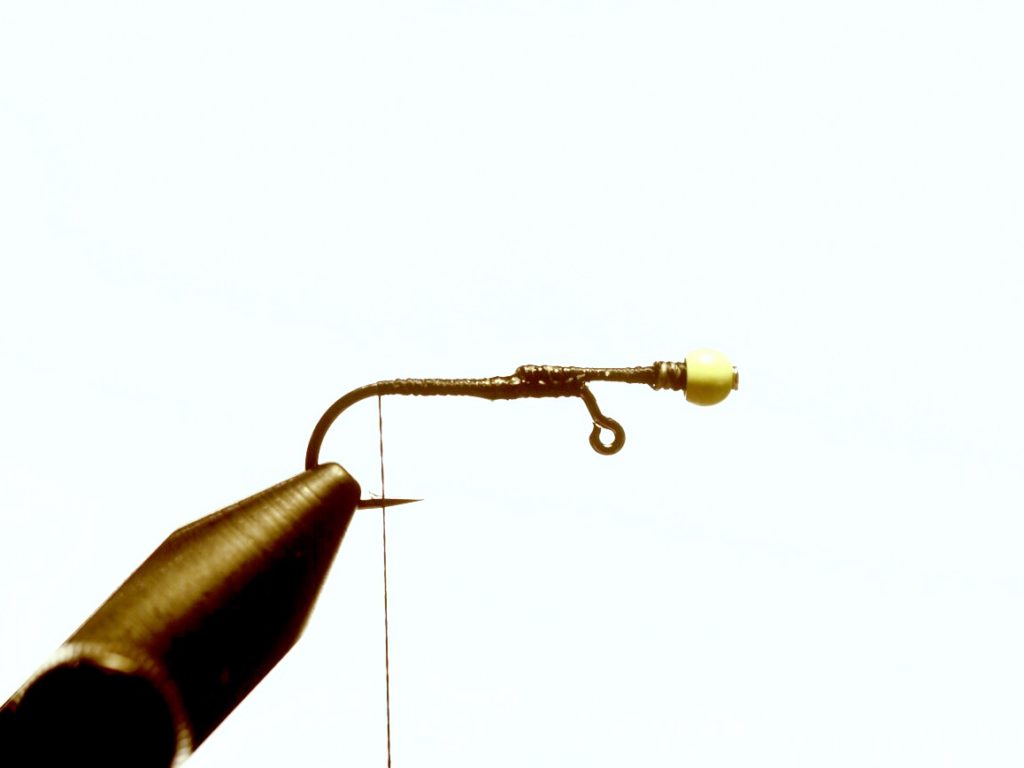
Start your thread behind the lead and over it so seat the bead at the front of the fly and then take your thread rearward to the bend of the hook.
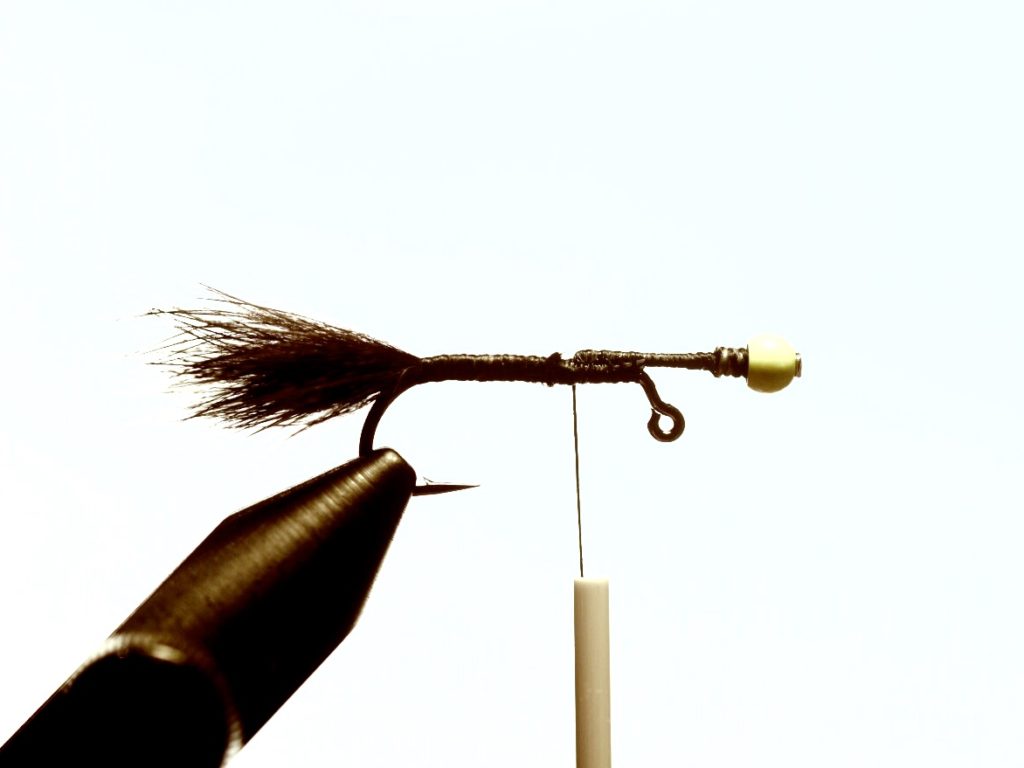
Tie in a clump of black rabbit fur cut from the hide of a zonker strip and tie in at the back of the hook. I like to keep the butt ends as long as I can so that I can fill in that bump where the pin ends on the shank.
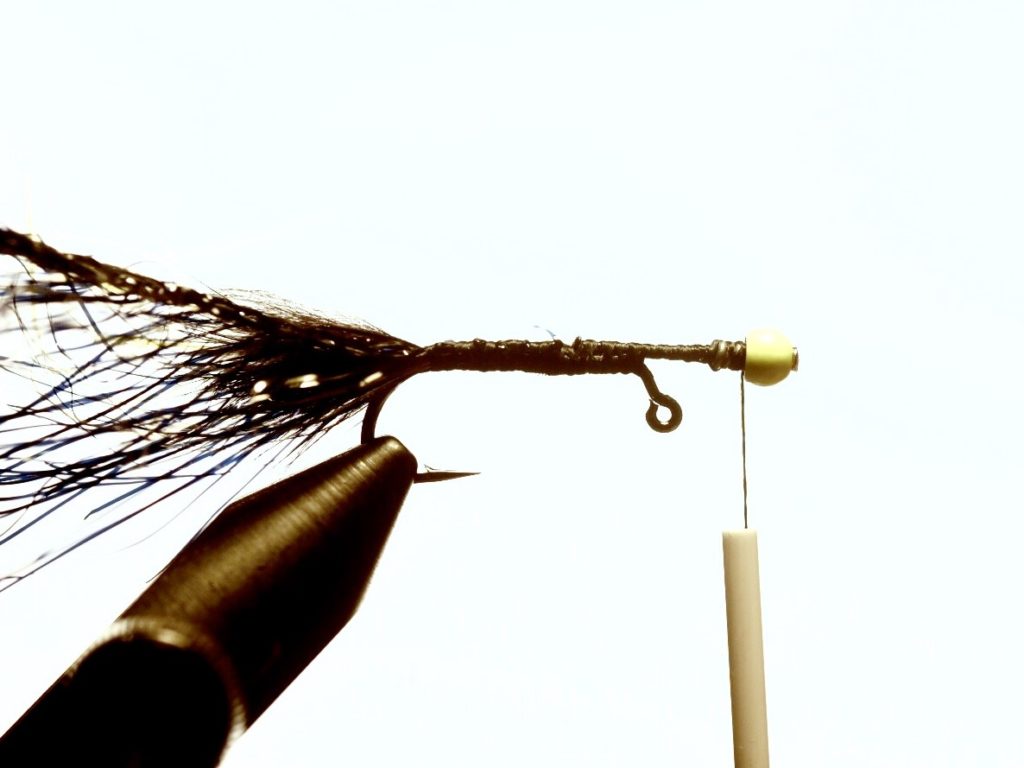
Now we are going to tie in a length of UV black polar chenille at that mid-point, again to help fill in the gap made by the pin, from here we are going to tie it in rearward to the base of the tail and then we will bring our thread all the way back to behind the bead.
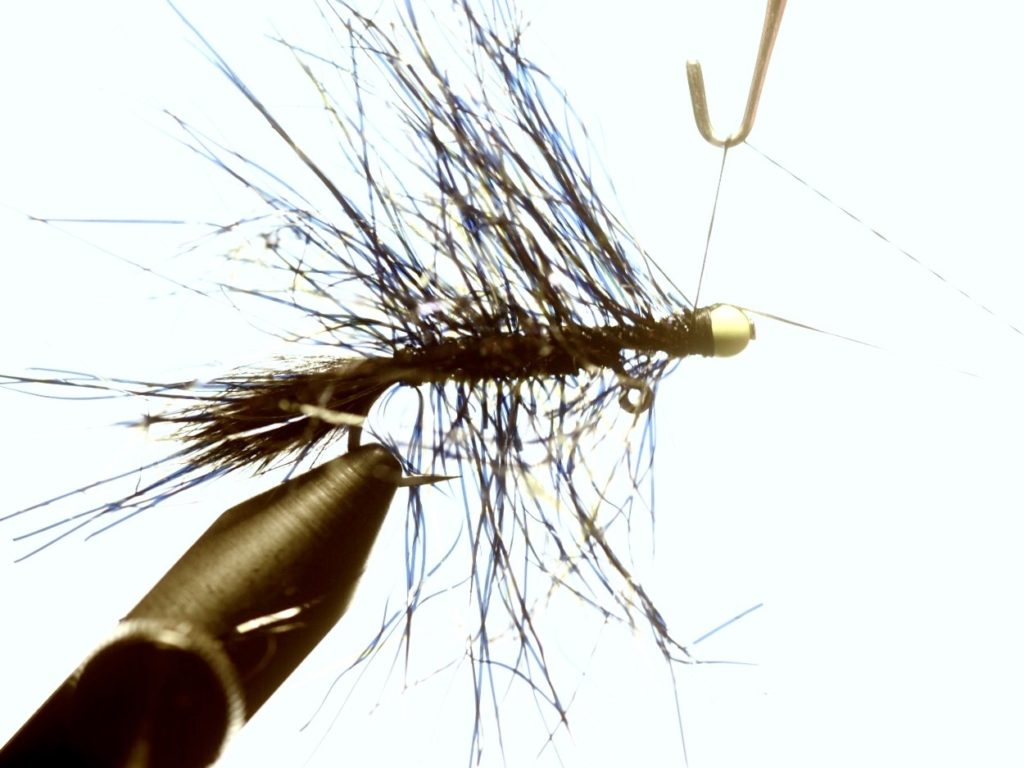
Palmer your polar chenille forward with touching turns all the way to behind the bead. I like to take a couple snug wraps at the eye of the hook to fill in that awkward angle where the eye and pin start to separate from the shank. Once you have reached the bead, tie off the chenille and whip finish.
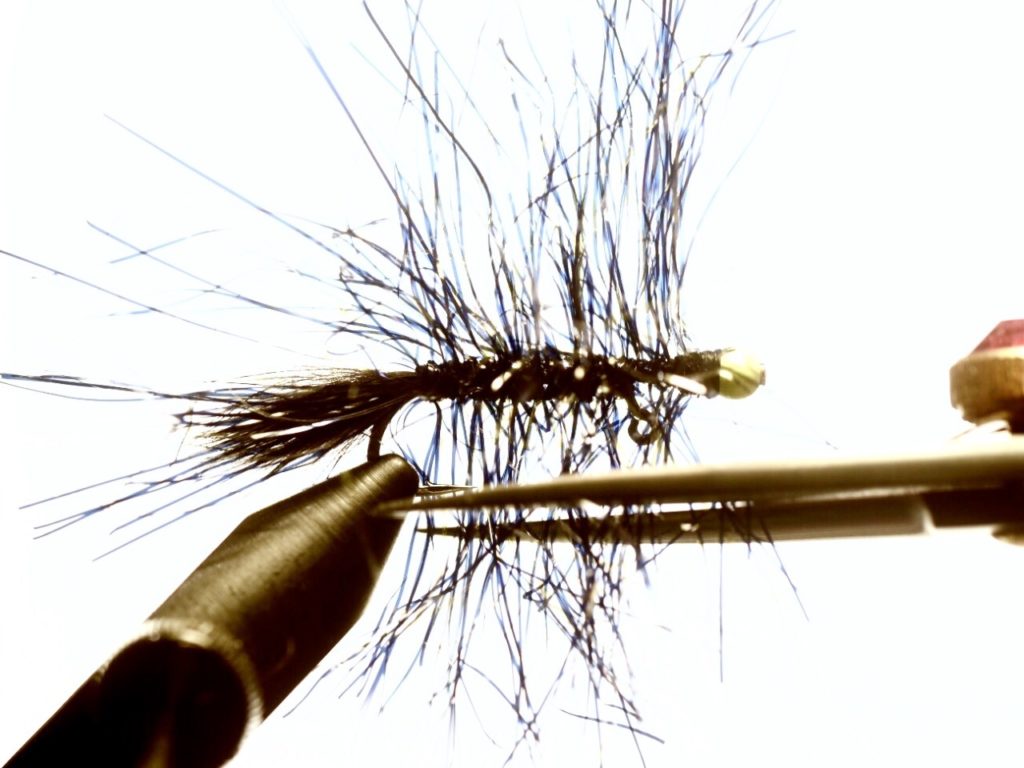
With your tying done for this pattern, I like to fluff up the chenille with a brush of velcro, so that it is sticking out 90 degrees from the shank all around the hook. Now we will trim the excess length of the chenille so that it is a touch longer than the hook gap all the way around the shank. I like to leave the odd longer fiber sticking out the back of the hook just to add some flash into the tail.
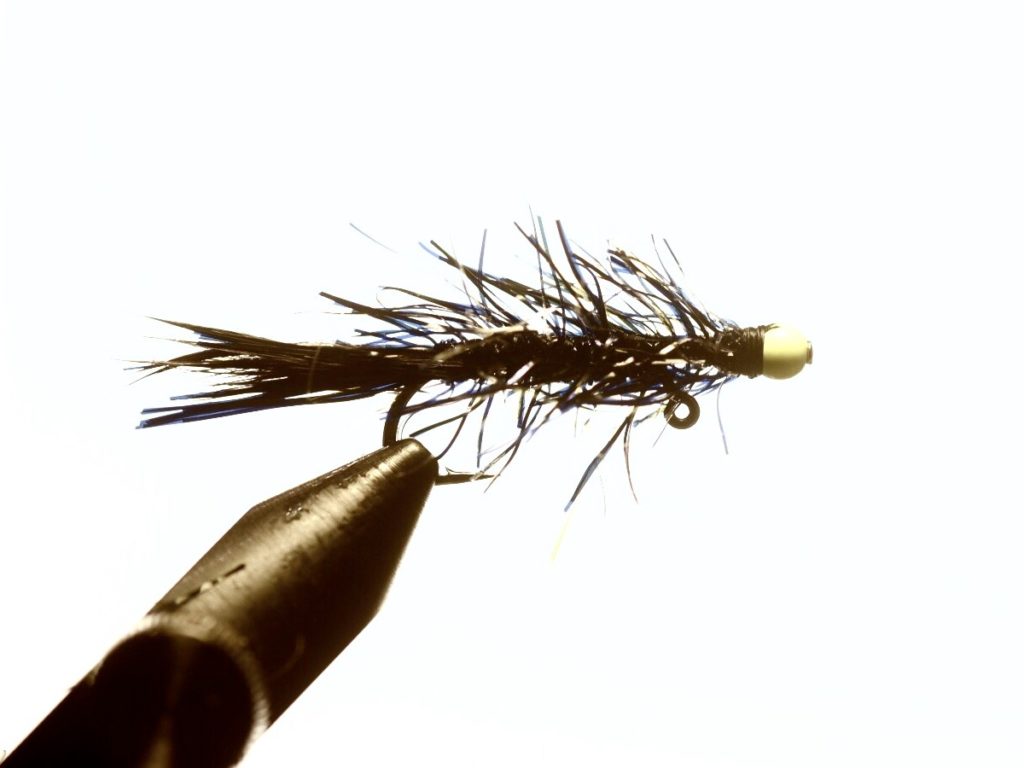
When you are done trimming the chenille it will be sticking out perpendicular to the hook shank. Polar chenille is quite soft and when it gets wet it will matte down quite a bit and still have some movement to it.
That’s it for this week’s tutorial. These patterns are really easy to tie, and they add another dimension to your fly boxes. I have seen this basic principal used with nymphs, fry and baitfish patterns, the only limiting factor is your imagination. We have a good selection of 60 and 90 degree jig hooks as well as the pins needed for the balancing portion of the fly in the shop. If you have any questions or if you would like an in person tutorial please don’t hesitate to come on into the shop, we would love to show you how to tie this or any other patterns up!
Happy tying!
Zach Copland
FRESHWATER FISHING REPORTS
Squamish River Fishing Report
Ka-BOOM – The river rose almost 2 meters this week and fishing on the Squamish system is going to be limited. This happens every year when we see the first heat wave of spring. It is caused by heavy snow melt and commonly referred to as freshet. Though there may still be windows of fishing on the system if things get cold again, for the most part, fishing will be over until the end of summer. We will tune in when we start hearing reports of pinks showing up around July/August.
Harrison River Fishing Report
The Harrison is also on the rise. Because it is lake fed it does not blow out like the Squamish but shore access is getting more of a challenge. If you can access this system with a boat you should still find good cutthroat opportunities. As freshet kicks in you will see the water turn a heavy blue color. This can make fishing more of a challenge but you should still have some time before it gets bad. If you get out, we would love some more one the water reports!
STILLWATER FISHING REPORTS
Lake Fishing Reports
As you may expect, the reports from lakes near and far have been absolutely fantastic. From the small crater lakes in the Pemberton/Squamish area, all the way to the trophy lakes of the Kamloops region. We’ve heard awesome reports from Alice and Stump on the Squamish side of things. Here’s an awesome photo of the apparent Ant hatch that is going on right now!
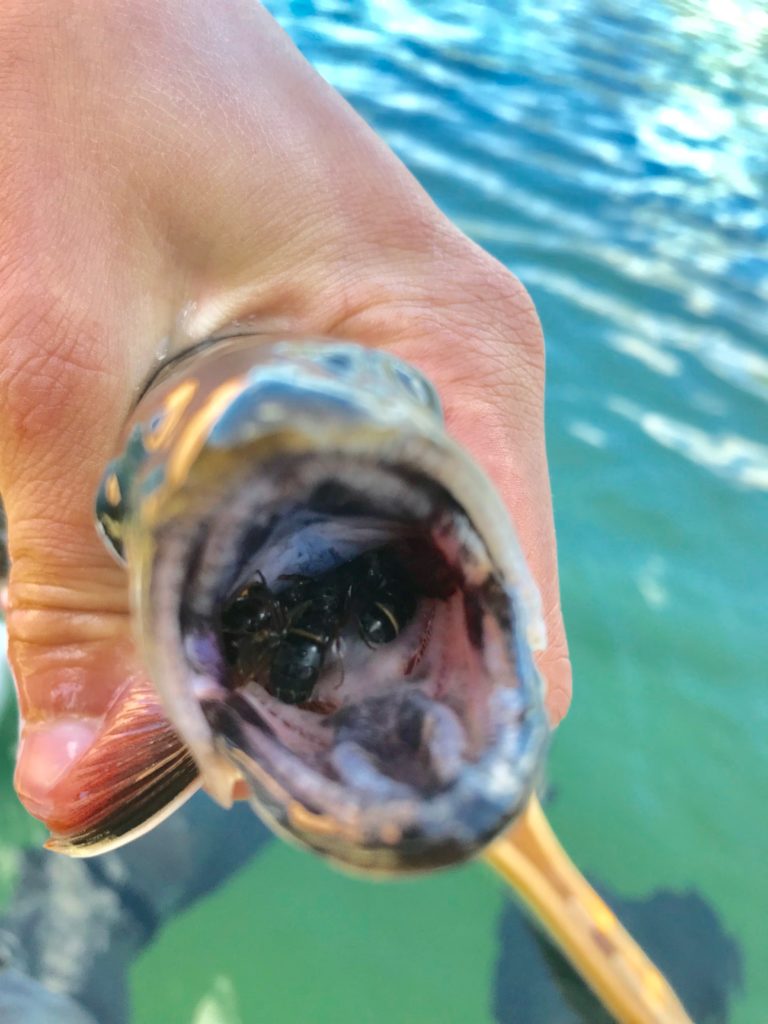
For the local lakes, things have slowed down a bit, Buntzen, Deer, Sasamat, And Green Timbers have produced fish on a multitude of gear and flies. This indicates that there are still plenty of stocked trout in the lakes, and they haven’t smartened up to the anglers. My biggest suggestion for you wanting to stay local is to cover water and look for structure. Even a small bush or stick in the water can attract fish to hold, and that means easy targeting for you!
And then we carry on to the Kamloops/Merritt/Kane Valley region. We’ve had great reports from Stump, Peter Hope, And for those of you who have a Douglas Lake trip planned for the long weekend, there’s been good fishing there as well. Nearly all, if not all lakes have had a common thread of Chironomid patterns working. Generally speaking, we’re fishing size 16-14 white beaded chronnies with your body colour staying on the natural side of things, brown, black or olive.
Most any lake you’d want to fish has iced off already, or if ice remains, the road is generally impassable with snow. a safe bet would be anything lower than 3750ft and south of Kamloops.
I’ll be spending a few days at Roche over the weekend, so expect to have an updated report for the lakes in the region next week.
Also be aware guys, we’ve had tons of reports of Conservation Officers in the Kamloops region. So, make sure to dot your i’s and cross your t’s when it comes to licensing and following provincial watercraft laws.
Aidan Munro
SALTWATER FISHING REPORTS
Vancouver Saltwater Salmon Fishing Report
The salmon fishing has been pretty awesome these past few days. It did slow down a bit around the new moon, but 2 days after that, it was very good fishing and has been good right up too and including today. We have been fishing a lot around Cowan Point and in the lee of the NW winds, which have were relentless most of the week. Luckily most days have been very good off Cowan and hot depths have been 90-130 on the riggers in 200-450 feet of water. The winds finally did die down today and we have boats over at Thrasher, its flat calm, and they are hammering fish. I am not surprised, mid May is always very good at Thrasher.

When it comes to tackle, most things have been working if they are fairly bright. Productive flashers this week have been Super Betsy, Green Onion Glow, Salty Dawg, BC, STS, Chartreuse Phantom, and PA Custom in chartreuse. The same can be said about spoons, hootchies and teaser heads. We have been doing well on 3.5 Irish Cream and 3.5 Trailhead spoons, chartreuse or green splatter back hootchies, and chartreuse and green glow teaser heads.
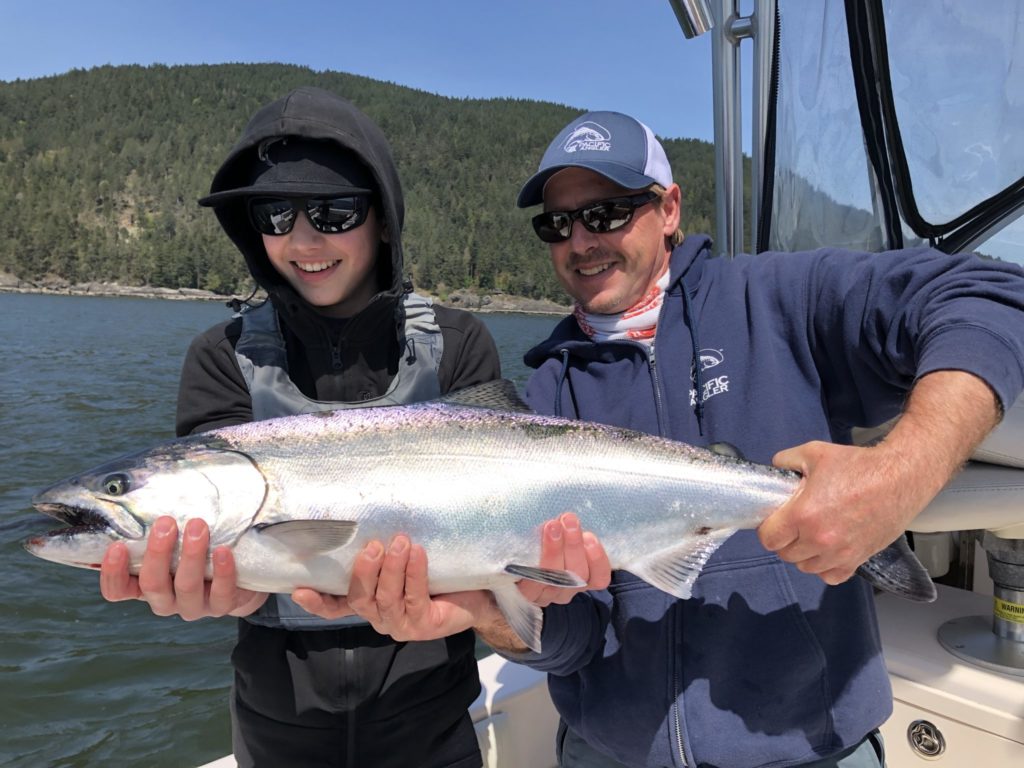
If you want to book a catch and release chinook trip with lots of action, and pick up some prawn and crab traps on the way home, book now. It’s on! We also have a special “catch and release package” for our guests, which consists of sockeye fillets, cold smoked sockeye, and candied sockeye. So book a trip and we are going to create some great chinook memories and send you home with some fish for the BBQ and some prawns and crab as well! Give us a call at 778.788.8582 to book your trip.
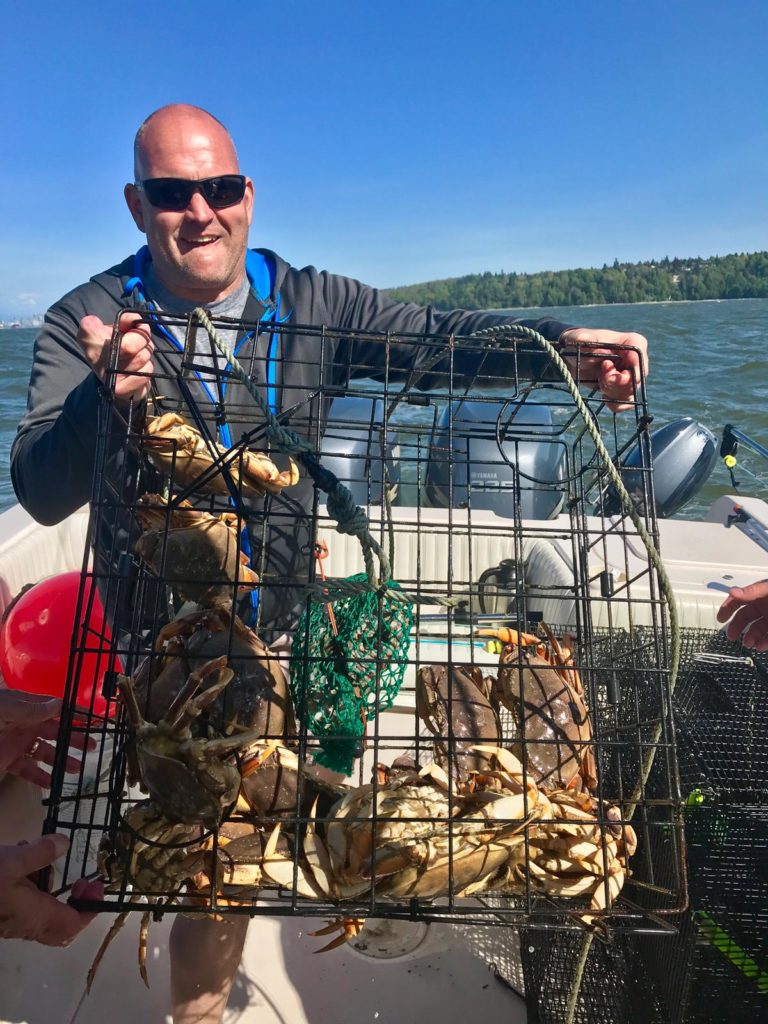
We’ll see you in the shop or on the water!
Jason Tonelli


